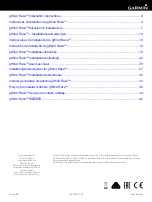
CONTENTS
C
ONTROL AND
M
ETERING
P
ANEL
...........................................................................................................................1
T
RANSMITTER
C
ONTROL
C
IRCUIT BOARD
A
SSEMBLY
...........................................................................................1
Control
and
Metering
Panel
40D1985G1
Transmitter
control
and
monitoring
is
performed
by
the
Control
and
Metering
Panel.
This
19"
wide,
3
unit
(5
3
")
panel
serves
primarily
as
a
mechanical
mounting
for
the
transmitter's
control
switches,
status
indicator
lights,
and
a
multifunction
meter.
It
also
is
the
mounting
for
the
control
circuit
board
described
below,
and
for
an
output
metering
circuit
board.
The
transmitter
control
panel
features
as
seen
from
the
front,
are:
•
A
panel
meter
calibrated
0
‐
125
percent,
and
a
0
‐
100
linear
scale;
•
The
meter
input
selector
switch
for
forward
and
reflected
power,
IPA
output
level,
and
AGC
voltage;
•
Pushbuttons
for
ON,
OFF,
REMOTE/LOCAL,
AGC
ON/OFF,
TX
RESET;
•
A
screwdriver
adjusted
potentiometer
for
the
desired
AGC
level,
hence
transmitter
output
power;
•
Five
LEDs
providing
indications
(from
left
to
right)
when
lighted:
o
EXT
1
interlock
is
closed,
o
the
output
amplifier
TEMP
thermostat
is
cool,
o
EXT
2
interlock
is
closed.
o
VSWR
L/O
when
lighted
means
three
major
VSWR
events
have
occurred
during
a
short
time
and
the
transmitter
is
now
off
the
air,
and
o
VSWR
C/B
lights
up
during
a
VSWR
event
that
is
sufficient
to
cause
the
transmitter
power
output
to
decrease,
or
even
to
momentarily
turn
off
the
transmitter.
The
transmitter
is
provided
with
a
VSWR
cutback
function
that
either
reduces
its
power
output
to
save
it
from
harm
in
the
event
of
gradual
occurrences
such
as
antenna
ice
build
‐
up,
or
momentarily
takes
it
off
the
air
from
random
events.
Three
VSWR
events
occurring
rapidly
in
a
short
time
will
cause
the
VSWR
Lockout
mode
to
turn
the
transmitter
off
until
it
is
reset.
Random
VSWR
events
normally
do
not
cause
lockout
unless
the
reflection
is
sustained,
causing
repeated
momentary
tripping
and
ultimate
lockout.
Antenna
or
line
damage
occasionally
can
be
a
factor,
but
usually
ice
accumulation
on
the
antenna
causes
sustained
high
VSWR.
Transmitter
Control
Circuit
board
Assembly
30C1829G1
See
Figure
1
and
Figure
2.
There
are
seven
connectors
on
the
Control
circuit
board.
These
connectors
perform
the
following
functions:
•
J1
interconnects
with
J3
of
the
Metering
board
via
a
34
‐
wire
ribbon
cable.
•
J2
connects
elsewhere
in
the
transmitter,
such
as
the
exciter
and
the
PA,
and
to
the
meter.
•
J3
connects
to
the
external
interlocks,
and
any
special
local
controls
for
TX
off
and
on
functions.
•
J4
interconnects
with
J4
of
the
Metering
board
for
the
AGC
potentiometer
and
switch
wiring.
•
J5
is
a
15
‐
contact
D
‐
shell
connector
provided
for
user
remote
control
system.
PUB96-32 Rev 2 August 29, 2005
32-1
TX Control Panel 40D1985G1







































